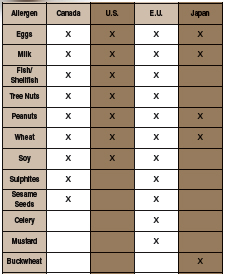
Technical Talk: Allergen Overview
March 4, 2008
By Dr. John Michaelides
This column is written by Dr. John Michaelides of the Guelph Food Technology Centre 519-821-1246, www.gftc.ca .
Question: How do food allergens affect the baking industry?
This column is written by Dr. John Michaelides of the Guelph Food Technology Centre 519-821-1246, www.gftc.ca .
Question: How do food allergens affect the baking industry?
Answer: There is a rising concern in the food industry about the presence of allergens in ingredients and finished food products. This concern is caused by the growing number of allergen-sensitive individuals who can suffer serious and severe reactions to products that contain allergenic ingredients. These reactions can vary from sensitivity (also known as adverse food reaction), intolerance (abnormal physiological response of the body), hypersensitivity (immunologic reaction) or anaphylaxis (severe and sometimes fatal reaction to food).
This developing issue poses a challenge for food industry as more individuals demand greater information about the food they eat. The manufacturing of food products is a complex process requiring a plethora of ingredients which are themselves complex. Sometimes correct information about the contents of these ingredients is difficult to obtain or some of the components are not declared at all, in this situation the risk of contamination with allergens is very high.
The Canadian Food Inspection Agency (CFIA) recognizes nine priority food allergens in Canada. They include peanuts, tree nuts, sesame seeds, milk, eggs, fish (including crustaceans), soy, wheat and sulphides. The general reference to tree nuts includes almonds, Brazil nuts, cashews, hazelnuts, macadamia nuts, pecans, pine nuts, pistachios and walnuts. It is not clear whether chestnuts can also cause allergenic reactions. The fish and crustaceans list contains crab, crayfish, lobster, shrimp, clams, mussels, oysters and scallops. Wheat is listed as food allergen based on the content of gluten protein; however, we need to consider that other grains also contain gluten. For instance, grains such as rye and barley should also be avoided by people suffering with gluten intolerance such as Celiac Disease. The sulphites category includes many ingredients commonly used in foods such as potassium bisulphate, potassium metabisulphite, sodium sulphite. These nine allergenic core ingredients have to be declared on the ingredient label in Canadian food products.
Food regulatory agencies of other countries have their own regulations that mandate the declaration of allergenic ingredients. We have to be aware of these regulations when we are exporting food products to these countries.
 |
| Table 1. Allergenic ingredients that need to be declared in the U.S., the E.U. and Japan compared to Canada.
|
Foods that result in allergenic reactions contain very specific components that are responsible for causing the reactions. These components are usually proteins and in some cases represent very small specific peptides of these proteins. Consider dairy products: one of the main components of milk, beta-lactoglobulin, is responsible for allergic reactions. Beta-lactoglobulin is associated with whey, and whey protein concentrates and isolates are widely used as ingredients in many food products including infant formula and baked goods. Another protein in milk that is responsible for allergenic reactions is casein, a functional ingredient in the production of cheese. Some soy cheeses may also contain casein, which is used to enhance texture. Egg whites contain most of the protein in eggs with four allergenic components: ovomucoid, ovalbumin, ovotransferrin and lysozyme. The egg yolk allergenicity is not as severe as that of the egg whites.
Some allergenic reactions have been reported with wheat; however, the major concern relates to Celiac Disease. Celiac Disease is an adverse reaction to specific proteins (prolamins) of wheat, barley, rye and possibly oats. These specific proteins are gliadin from wheat, hordein from barley, secalin from rye and avenin from oats. The involvement of the oat protein is under debate and the results are not quite clear yet. These proteins adversely affect the sensitive individual by causing a modification of the lining of the intestine thus affecting the absorption of nutrients. The number of individuals suffering from Celiac Disease is on the rise but some experts really attribute this increase to a better diagnosis of the disease. The only treatment is a gluten-free diet on a permanent basis. In Canada, a gluten-free declaration means that there are no detectable levels of gluten in the food. The Codex Alimentarius currently defines gluten-free products as those containing less than 200ppm; however, there are discussions to reduce this to 20ppm. Gluten is the major functional protein that enables us to produce the desirable quality baked goods we are accustomed to in our current diets. No other known proteins provide similar performance in baked goods. Therefore, it is very difficult to produce gluten-free baked goods with the same quality as those produced from wheat flour.
With the complexity of ingredients and food manufacturing processes the task of providing allergen-free products for the consumer is difficult. However there are certain practices that manufacturers can adopt to minimize the risks of contamination of the finished foods with allergen. Sanitation and proper cleaning procedures are well adopted by the industry. The methods of detection of these allergens are improving and are becoming more accurate and faster with levels of detection down to a few ppms. Techniques like ELISA immunoassays and DNA detection methods are readily available. These techniques can be regularly performed on the ingredients to ensure they are free of contaminants, but in many cases can detect the allergens in finished foods as well.
For more information, or fee for service help with product or process development needs please contact the GFTC at 519-821-1246, by fax at 519-836-1281, by e-mail at gftc@gftc.ca .
Print this page
Leave a Reply